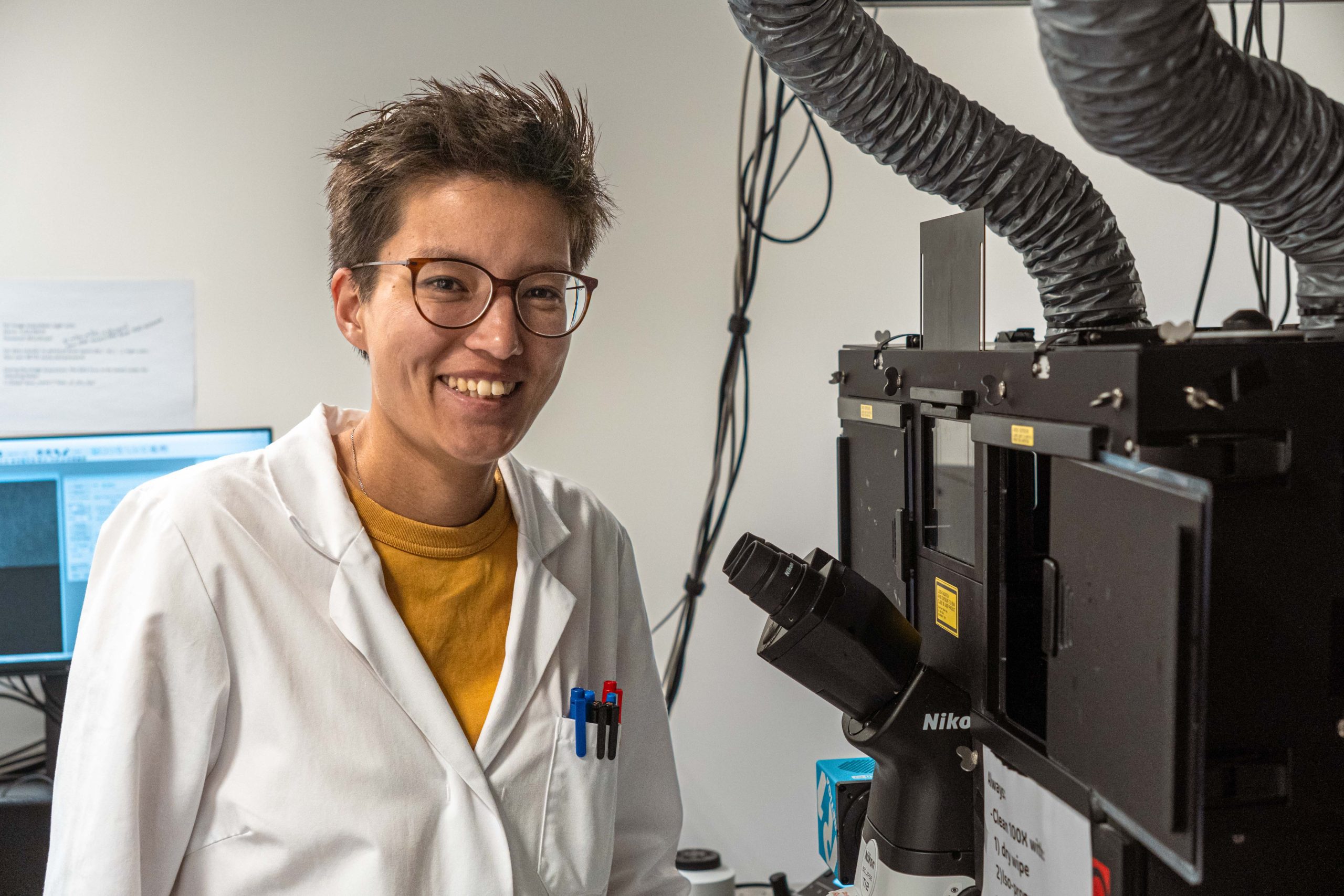Using a sophisticated combination of two optical research techniques, scientists can now examine thousands of DNA variations simultaneously. This means a huge acceleration in genetic and biological research.
Carolien Bastiaanssen at the fluorescence microscope. (Photo: Thijs van Reeuwijk)
Their publication in the science journal Science is good news for molecular biologists in labs, as the new technology will allow them to screen many more different molecules and DNA variants for their properties. TU Delft senior researcher Prof. Chirlmin Joo (Faculty of Applied Sciences, AS) said in the press release that ‘We expect applications in genetic research, drug development and biotechnology to start emerging within the next five to 10 years.’
DNA, RNA and proteins are the key players in our bodies’ cells. To understand how these molecules function, you need to know their spatial structure sequence.
‘Traditional techniques usually take hours per sequence’
Delta spoke to Dr Carolien Bastiaanssen, second author after Dr Ivo Severins who is currently in South Korea. Both work at the Faculty of Applied Sciences. Bastiaanssen explains that over 4,000 different DNA sequences were scanned simultaneously. Each building block in DNA can have one of four possible values (A,C,T or G), so an intermediate of six bases has 4x4x4x4x4x4 = 4,096 variations. “It took five days to scan all of them. With conventional technology it would have taken years,” says Bastiaanssen. That shows you how dramatic the acceleration is.
“Traditional techniques that examine one sequence at a time usually take hours per sequence. With SPARXS, we can measure millions of molecules within a day to a week,” said Chirlmin Joo. SPARXS is the sparkling name of this new technology and stands for Single-molecule Parallel Analysis for Rapid eXploration of Sequence space, with the latter term denoting a large number of DNA variations.
The two techniques brought together by the biophysicists are single-molecule fluorescence and next generation sequencing (NGS).
Single-molecule fluorescence enables changes in the structure of different DNA molecules to be observed under the microscope thanks to fluorescent labels used to mark the molecules. By using different lasers and various labels, molecules can be tracked individually. It is a wonderful technique, but you can only study one variation at a time.
Next generation sequencing is a DNA analysis method developed in 2008 that can now read millions of different DNA sequences simultaneously. This is in contrast to a conventional DNA reader that reads one DNA strand at a time. NGS also works with fluorescent labels that show which nucleotide attaches to a strand. The colour of the fluorescence indicates the information that can be read. And this can be done for millions of DNA strands simultaneously, like as many coloured points of light in the dark.
‘It took a year to determine whether combining the two techniques is feasible’
Both techniques work with microscopy, lasers and fluorescent markers. So combining the different techniques was not such a long shot, but getting to that point was far from easy. “It took one year to determine whether combining the two techniques was feasible and another four years to develop a working method,” Joo says. “And then another two years to ensure the accuracy and consistency of the measurements.”
For their paper in Science, the researchers produced 4,096 different DNA sequences and determined whether and how fast they switched between two possible structures. That was to demonstrate SPARXS. Now that the technology is in place, many practical and useful applications lie ahead. As examples the researchers cite: interaction between DNA or RNA and proteins, and screening of proteins or chemicals.
“They have combined next generation sequencing with single molecule fluorescence in a very nice ingenious way,” comments Molecular Biophysicist Professor Wouter Roos (University of Groningen) who was not involved in the research. “I expect we will see more publications on this in the coming years, including from other groups that will also try it. But I also always look to see if the group itself continues their work. If they come up with new articles announcing improvements, it shows that they believe in it themselves. And then other groups usually follow suit.”

Single molecule fluorescence
Next generation sequencing
Animation Sparxs
Do you have a question or comment about this article?
j.w.wassink@tudelft.nl


Comments are closed.